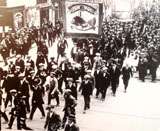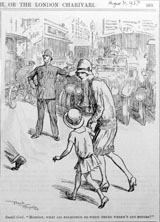Industrial Unrest

Policing industrial disputes was another area where the police were criticised for being 'political' in their activities. The role of the police in managing industrial disputes was extended beyond the limits of the capital. In 1910, for example, a particularly active Home Secretary, Winston Churchill, sent men from the Metropolitan Police to deal with industrial unrest outside the capital; here men from 'R' (Greenwich) Division are photographed at Tonypandy during the coal strike of 1910.

One of the most celebrated instances of industrial action during the early twentieth century was the General Strike of 3-12 May 1926. This photograph is dated from May Day Day in Cotton Street, Poplar. Troops were used during the strike, at least two officers look on as troops escort food convoys along the East India Dock Road. The Commissioner's Office published a newsheet during the strike and it shows how the senior officers at least took a hostile attitude to the strikers: note how it speaks of 'hooliganism' as being a potential threat and how some railwaymen 'remained at their posts'. The strike lasted nine days, and ended as a crushing defeat for organized labour.
Disorder linked to industrial disputes continued into the 1930s. For example in October 1932 a crowd of 10,000 unemployed men from all over the United Kingdom marched to London. They assembled in and around Hyde Park on 27 October. A meeting at Speaker's Corner was initially orderly. Once again there is dispute about how trouble started. Was it aggressive policing or, as the official line played it, a hooligan element in the crowd? A lorry following a contingent of unemployed men from Lancashire was said to contain 154 ash staves studded with nails. Sporadic clashes continued in the centre of the metropolis over the next few days.
 "Mother, what did policemen do when there weren't any motors?"
"Mother, what did policemen do when there weren't any motors?"